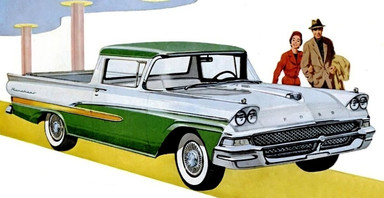Posted by KYTE on 17th May 2017
Work and Play
Admiration or strange fascination, the Ranchero is one of
the most unique and handy vehicles Ford has rolled out.
Ford's Model T and Model A trucks can often be seen sporting truck bed options.
The evolution of the pickup truck has spawned from there, evolving more into
what we have today with separated cabs and beds.
The idea of a coupe utility vehicle seems to have originated in Australia where
there was a demand for something nice like a sedan that could still do hard
work and haul if needed. In 1932 a farmer's wife in Victoria wrote a letter to
Ford Australia regarding this. Ford answered by putting together 2 door with bed Coupe Utility vehicles. Other brands in this region soon began to put their own
designs together following this fashion.
Ford America decided to bring the style over and released the Ranchero in
December 1956 for the '57 lineup. It became so popular that competitors began
to imitate the design, such as GM with the El Camino in 1959.
The first Ranchero was built on the 1957 standard full sized Ford platform and
based around the 2 door Ranch Wagon and the Courier sedan delivery. The back
was left open, the bed was reinforced, along with integrating the cab and cargo
box. Some early builds were labeled as Fairlanes but the line was originally
sold through Ford's truck division and marketed towards pickup buyers, using a
heaven lean toward American Southwest imagery.
The market loved the new design, a niche was filled, and more models followed.
Changes to increase the length were a big part following Ranchero designs until
the rise in popularity of smaller, European cars.
In 1960 the Ranchero shrunk, being based on the Ford 2 door delivery variant of
the compact Falcon. At this time it began being marketed as the Falcon
Ranchero. Three different coupe utility bodies became available with changed to
cargo box size, length of bed, and a 4 door setup all as options.
In 1966 it officially became a line of its own, released solely as the
Ranchero.
Things began to slowly stretch out again and the 1968 Ranchero became larger.
Many design notes were taken from the Torino including sheer size and cut of
angles. Three trim levels were offered: basic Ranchero, 500 (trimmed like the
Fairlane 500), and the GT (based on the Torino GT).
Forthcoming models became boxier and in 1970 had a complete restyle for the
Ranchero and the front became pointed with other lines more curved.
1972 brought more radical changes such as a jet intake inspired oval front end
and a heavier design but had to be immediately redesigned for 1973 due to
federal front impact protection standards.

The intended replacement for the Torino, the Ford LTD II, became the new
platform for the Ranchero in 1977. From here on out a demand for smaller,
lighter trucks changed the direction of the market and pulled popularity away
from the Ranchero. 1979 was the final year for the Ranchero in the US.
Also in 1979, a limited run car called the Ford Durango was planned and
produced. It shared similarities to the Ranchero and was built in collaboration
with National Coach Works. No official production numbers were kept and estimates
say around 200 were built.
The Ranchero is highly collectible but sometimes overlooked, even when compared
to the El Camino which went on to be produced for a bit longer. Whispered
rumors of a new Ranchero fill the air as concept art for what a modern build
would look like is being circulated.

